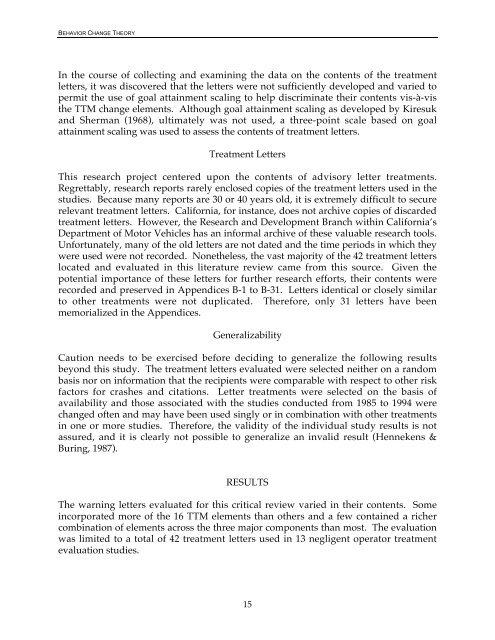Application of Behavior Change Theory to the Development
Application of Behavior Change Theory to the Development
Application of Behavior Change Theory to the Development
You also want an ePaper? Increase the reach of your titles
YUMPU automatically turns print PDFs into web optimized ePapers that Google loves.
BEHAVIOR CHANGE THEORY<br />
In <strong>the</strong> course <strong>of</strong> collecting and examining <strong>the</strong> data on <strong>the</strong> contents <strong>of</strong> <strong>the</strong> treatment<br />
letters, it was discovered that <strong>the</strong> letters were not sufficiently developed and varied <strong>to</strong><br />
permit <strong>the</strong> use <strong>of</strong> goal attainment scaling <strong>to</strong> help discriminate <strong>the</strong>ir contents vis-à-vis<br />
<strong>the</strong> TTM change elements. Although goal attainment scaling as developed by Kiresuk<br />
and Sherman (1968), ultimately was not used, a three-point scale based on goal<br />
attainment scaling was used <strong>to</strong> assess <strong>the</strong> contents <strong>of</strong> treatment letters.<br />
Treatment Letters<br />
This research project centered upon <strong>the</strong> contents <strong>of</strong> advisory letter treatments.<br />
Regrettably, research reports rarely enclosed copies <strong>of</strong> <strong>the</strong> treatment letters used in <strong>the</strong><br />
studies. Because many reports are 30 or 40 years old, it is extremely difficult <strong>to</strong> secure<br />
relevant treatment letters. California, for instance, does not archive copies <strong>of</strong> discarded<br />
treatment letters. However, <strong>the</strong> Research and <strong>Development</strong> Branch within California’s<br />
Department <strong>of</strong> Mo<strong>to</strong>r Vehicles has an informal archive <strong>of</strong> <strong>the</strong>se valuable research <strong>to</strong>ols.<br />
Unfortunately, many <strong>of</strong> <strong>the</strong> old letters are not dated and <strong>the</strong> time periods in which <strong>the</strong>y<br />
were used were not recorded. None<strong>the</strong>less, <strong>the</strong> vast majority <strong>of</strong> <strong>the</strong> 42 treatment letters<br />
located and evaluated in this literature review came from this source. Given <strong>the</strong><br />
potential importance <strong>of</strong> <strong>the</strong>se letters for fur<strong>the</strong>r research efforts, <strong>the</strong>ir contents were<br />
recorded and preserved in Appendices B-1 <strong>to</strong> B-31. Letters identical or closely similar<br />
<strong>to</strong> o<strong>the</strong>r treatments were not duplicated. Therefore, only 31 letters have been<br />
memorialized in <strong>the</strong> Appendices.<br />
Generalizability<br />
Caution needs <strong>to</strong> be exercised before deciding <strong>to</strong> generalize <strong>the</strong> following results<br />
beyond this study. The treatment letters evaluated were selected nei<strong>the</strong>r on a random<br />
basis nor on information that <strong>the</strong> recipients were comparable with respect <strong>to</strong> o<strong>the</strong>r risk<br />
fac<strong>to</strong>rs for crashes and citations. Letter treatments were selected on <strong>the</strong> basis <strong>of</strong><br />
availability and those associated with <strong>the</strong> studies conducted from 1985 <strong>to</strong> 1994 were<br />
changed <strong>of</strong>ten and may have been used singly or in combination with o<strong>the</strong>r treatments<br />
in one or more studies. Therefore, <strong>the</strong> validity <strong>of</strong> <strong>the</strong> individual study results is not<br />
assured, and it is clearly not possible <strong>to</strong> generalize an invalid result (Hennekens &<br />
Buring, 1987).<br />
RESULTS<br />
The warning letters evaluated for this critical review varied in <strong>the</strong>ir contents. Some<br />
incorporated more <strong>of</strong> <strong>the</strong> 16 TTM elements than o<strong>the</strong>rs and a few contained a richer<br />
combination <strong>of</strong> elements across <strong>the</strong> three major components than most. The evaluation<br />
was limited <strong>to</strong> a <strong>to</strong>tal <strong>of</strong> 42 treatment letters used in 13 negligent opera<strong>to</strong>r treatment<br />
evaluation studies.<br />
15
















